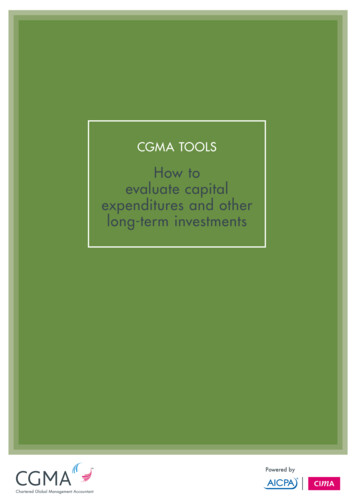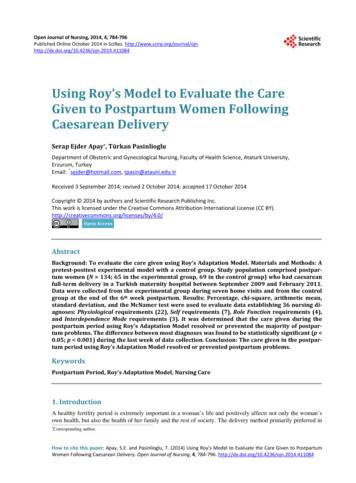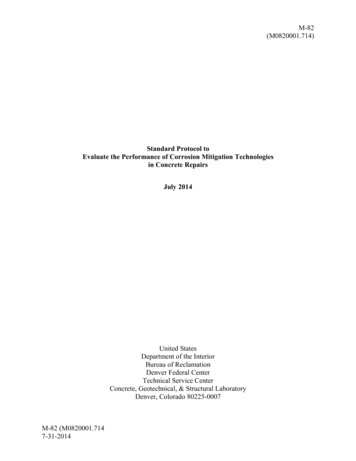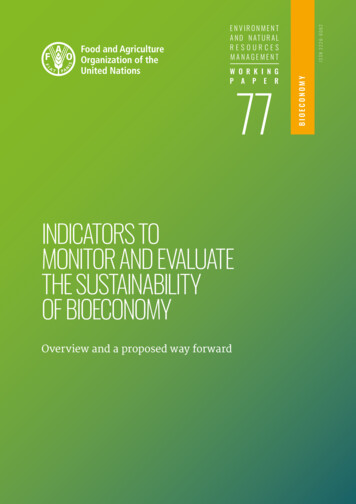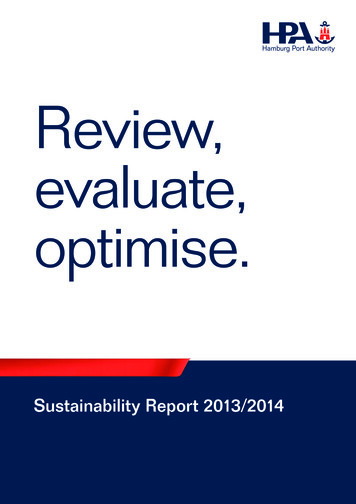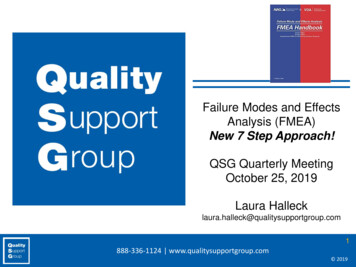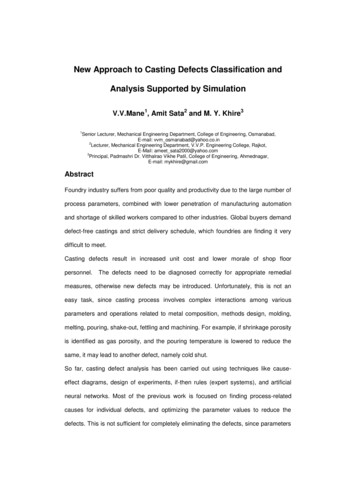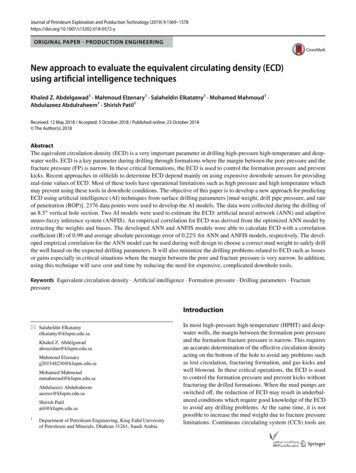
Transcription
Journal of Petroleum Exploration and Production Technology (2019) 72-yORIGINAL PAPER - PRODUCTION ENGINEERINGNew approach to evaluate the equivalent circulating density (ECD)using artificial intelligence techniquesKhaled Z. Abdelgawad1 · Mahmoud Elzenary1 · Salaheldin Elkatatny1 · Mohamed Mahmoud1 ·Abdulazeez Abdulraheem1 · Shirish Patil1Received: 12 May 2018 / Accepted: 5 October 2018 / Published online: 23 October 2018 The Author(s) 2018AbstractThe equivalent circulation density (ECD) is a very important parameter in drilling high-pressure high-temperature and deepwater wells. ECD is a key parameter during drilling through formations where the margin between the pore pressure and thefracture pressure (FP) is narrow. In these critical formations, the ECD is used to control the formation pressure and preventkicks. Recent approaches in oilfields to determine ECD depend mainly on using expensive downhole sensors for providingreal-time values of ECD. Most of these tools have operational limitations such as high pressure and high temperature whichmay prevent using these tools in downhole conditions. The objective of this paper is to develop a new approach for predictingECD using artificial intelligence (AI) techniques from surface drilling parameters [mud weight, drill pipe pressure, and rateof penetration (ROP)]. 2376 data points were used to develop the AI models. The data were collected during the drilling ofan 8.5″ vertical hole section. Two AI models were used to estimate the ECD: artificial neural network (ANN) and adaptiveneuro-fuzzy inference system (ANFIS). An empirical correlation for ECD was derived from the optimized ANN model byextracting the weights and biases. The developed ANN and ANFIS models were able to calculate ECD with a correlationcoefficient (R) of 0.99 and average absolute percentage error of 0.22% for ANN and ANFIS models, respectively. The developed empirical correlation for the ANN model can be used during well design to choose a correct mud weight to safely drillthe well based on the expected drilling parameters. It will also minimize the drilling problems related to ECD such as lossesor gains especially in critical situations where the margin between the pore and fracture pressure is very narrow. In addition,using this technique will save cost and time by reducing the need for expensive, complicated downhole tools.Keywords Equivalent circulation density · Artificial intelligence · Formation pressure · Drilling parameters · FracturepressureIntroduction* Salaheldin Elkatatnyelkatatny@kfupm.edu.saKhaled Z. Abdelgawadabouzidan@kfupm.edu.saMahmoud Elzenaryg201548230@kfupm.edu.saMohamed Mahmoudmmahmoud@kfupm.edu.saAbdulazeez Abdulraheemaazeez@kfupm.edu.saShirish Patilatil@kfupm.edu.sa1Department of Petroleum Engineering, King Fahd Universityof Petroleum and Minerals, Dhahran 31261, Saudi ArabiaIn most high-pressure high-temperature (HPHT) and deepwater wells, the margin between the formation pore pressureand the formation fracture pressure is narrow. This requiresan accurate determination of the effective circulation densityacting on the bottom of the hole to avoid any problems suchas lost circulation, fracturing formation, and gas kicks andwell blowout. In these critical operations, the ECD is usedto control the formation pressure and prevent kicks withoutfracturing the drilled formations. When the mud pumps areswitched off, the reduction of ECD may result in underbalanced conditions which require good knowledge of the ECDto avoid any drilling problems. At the same time, it is notpossible to increase the mud weight due to fracture pressurelimitations. Continuous circulating system (CCS) tools are13Vol.:(0123456789)
1570Journal of Petroleum Exploration and Production Technology (2019) 9:1569–1578used to control the ECD and allow better control of the formation pressure (Baranthol et al. 1995; Ataga et al. 2012).ECD is defined as the sum of the mud hydrostatic pressure and the annulus pressure loss acting on the formation(Haciislamoglu 1994). The annular clearance, mud weight,mud rheology, annular velocity (pump rates), cutting concentration in the annulus, and hole depth are the mainparameters which affect the annular pressure losses (APL).The two main components that affect the ECD are thecutting portion in the annulus expressed as equivalent staticdensity (ESD), and the mud-related parameters (Zhang et al.2013; Hemphill and Ravi 2011). Bybee (2009) introducedthe following equation to predict the ECD:(()ECD ESD 1 Ca 𝜌s Ca Δpg 10 3 H)a,(1)where ECD is the equivalent circulating density (g/cm3),ESD is the equivalent static density (g/cm3), Ca is the solidconcentration in the annulus (%), 𝜌s is the cutting (solids)density (g/cm3), Δp is the pressure losses in the annularspace (MPa), H is the well depth along the vertical (m),g is the gravitational acceleration, equal to 9.8 m/s2, a is aconstant taking into account the measurement units, equalto 8.345.Such numerical evaluations for predicting ECD valuesdid not take into account other factors affecting ECD whiledrilling such as flow geometry defined by well geometry,fluid resistance to flow defined by fluid rheology, and drillstring rotation. Ignoring these factors in the equation willincrease the error factors while estimating ECD (Caicedoet al. 2010; Costa et al. 2008).Recently, in the oil industry, downhole tools are used tomeasure and monitor changes of ECD to avoid well controlissues such as gas kicks, blowout, and formation fracturing(such as Erge et al. 2016; Rommetveit et al. 2010). The maintools used now are measurement while drilling (MWD) andpressure while drilling (PWD). These tools contain pressure sensors that can independently measure the bottomholepressure of the well during drilling, regardless of the factorscontrolling the ECD (such as Ettehadi et al. 2013; Dokhaniet al. 2016). The tools can give an accurate reading for ESDand ECD from the total pressure acting on the bottom of thewell during circulation. Comparing the ESD with ECD willgive a clear view about the reasons for ECD changes (suchas Vajargah et al. 2016; Osisanya and Harris 2005; Lin et al.2016). In addition to the expensive daily rates of such tools,there are some operating limitations for its application suchas pressure, temperature, and tool failures.The objective of this paper is to use different artificialintelligence (AI) techniques to develop a robust model topredict the ECD using surface drilling parameters suchas mud weight, surface drill pipe pressure and rate of13penetration. The models are developed using artificial neuralnetwork (ANN) and adaptive neuro-fuzzy inference system(ANFIS). In addition, an empirical correlation is extractedfrom the ANN model which can be used to calculate theECD from surface drilling parameters.Artificial intelligenceRecently, artificial intelligence (AI) has gained widespreadpopularity in many engineering fields due to its outstandingability to solve complex and non-linear problems (Naganawa et al. 2014; Razi et al. 2013). Petroleum industry dealsusually with big data. Artificial intelligence techniquesprovide actual benefits to model and manage these data.During the last few years, AI techniques including artificial neural network, fuzzy logic, support vector machine,genetic algorithms, adaptive neuro-fuzzy inference systemand swarm intelligence became increasingly popular in thepetroleum industry. AI techniques are applied in different aspects of petroleum engineering such as productionmonitoring, forecasting and multilateral well evaluation(Velazquez et al. 2012; Weiss et al. 2002), PVT parameterprediction (Weiss et al. 2002; Khaksar et al. 2016; Alarfajet al. 2012; Elkatatny and Mahmoud 2018), well integrityevaluation (Al-Ajmi et al. 2015), assisted history matching(Al-Thuwaini et al. 2006; Shahkarami et al. 2014), interpreting well logging data and well to well correlation (Saggafand Nebrija 1998; Wu and Nyland 1986; Lim et al. 1998a, b;Wiener et al. 1995; Denney 1998), well testing interpretation(Allain and Houze 1992; Houze and Allain 1992; Moussaet al. 2018), drilling fluid properties (Elkatatny 2017; Elkatatny et al. 2017), reservoir characterization (El Ouahedet al. 2003; Kumar et al. 2012a, b; Abdulhameed et al. 2017;Moussa et al. 2018), enhanced oil recovery (Van and Chon2017), rock mechanics (Sayadia et al. 2013; Elkatatny et al.2018a, b), and drilling optimization (Wang and Salehi 2015).Artificial neural network (ANN)An artificial neural network (ANN) reflects a similar systemto the operations of biological neural networks which is thereason for defining ANN as an emulation of biological neural systems (Nakamoto 2017). ANNs are at the leading edgeof computational systems used to produce, or at least mimic,intelligent behavior. ANN is capable of resolving paradigmsthat linear computing cannot process (Andagoya et al. 2015;Hemphill et al. 2007; Omosebiet al. 2012).The main processing elements of an ANN system areneurons. The ANN architecture contains at least three layers (input, hidden and output layer), in addition to a training algorithm and a transfer function (Lippmann 1987).Weights are constants which connect neurons in each layerwith the subsequent layer neurons (Hinton et al. 2006).
Journal of Petroleum Exploration and Production Technology (2019) 9:1569–1578Log-sigmoidal and tan-sigmoidal are the most commontransfer functions assigned to hidden layers while ‘pure linear’ is commonly used as activation function assigned tothe output layer. The input data points that go into an ANNmodel are normalized between 1 and 1 (Niculescu 2003).An ANN model is first trained using a back-propagation oferrors while data processing is taking place from the inputlayer all the way to the output layer. Then a comparisonis performed between the estimated and the actual data inthe output layer. The weights and biases of each layer areupdated to match the estimated outputs with the target values. This procedure continues until the error is reduced to acertain acceptable limit as shown in Fig. 1 (Liew et al. 2016;Naganawa et al. 2014; Razi et al. 2013).Unlike classical AI techniques which directly emulaterational and logical reasoning, neural networks are able toreproduce the underlying processing mechanisms whichgive rise to intelligence as an emergent property of complex adaptive systems (Shanmuganathan and Samarasinghe2016). ANN systems have successfully been developed anddeployed to solve capacity planning, pattern recognition,intuitive problem-related aspects, robotics, and businessintelligence (Andagoya et al. 2015; Hemphill et al. 2007).1571Neural networks gained high interest over the last fewyears in areas such as data analytics, data mining, and forecasting, (Bharambe and Dharmadhikari 2016).Adaptive neuro‑fuzzy inference system (ANFIS)Adaptive neuro-fuzzy inference system is an ANN systembased on Takagi–Sugeno fuzzy inference system. This technique was developed in the early 1990s to integrate bothfuzzy logic and ANN principles. ANFIS has the potentialto combine the benefits of both techniques in a single framework (Daneshwar and Noh 2013). Its inference system isbased on a set of fuzzy IF–THEN rules which can approximate nonlinear functions and act as a universal estimator(Shing and Jang 1993). Figure 2 shows an ANFIS architecture composed of four layers of several nodes (Hamdan andGaribaldi 2010). The output of the current layer nodes isserved as the input to the next layer nodes after manipulationby the node function in the current layer. During the trainingprocess, the training algorithm for ANFIS architecture willtune all the modifiable parameters to match ANFIS with thetraining data (Zarandi et al. 2010).MethodologyFig. 1 ANN system (Math works)To build the AI models using ANN and ANFIS techniques,the surface parameters including rate of penetration (ROP)in m/h, the weight of the mud flowing to the hole (MW) inlb/gal and the dill pipe pressure (DPP) in psi were used asinput parameters.The reason these parameters were called (surface) isthat they can be measured at the surface without downholemeasurements. By looking at these three input parameters,it is noticed that all other drilling parameters affecting ECDvalues are related to one or more of these three parametersas listed in Table 1. For example, the rate of penetrationFig. 2 Architecture of a typicaladaptive neuro-fuzzy inferencesystem (Hamdan and Garibaldi2010)13
1572Journal of Petroleum Exploration and Production Technology (2019) 9:1569–1578shown in Fig. 4. The previous steps represented the qualitycheck of the collected field measurements.The statistical analysis of the input parameters showsgood quality and variation that can be used for accurate prediction of ECD values using AI techniques (Table 2). Therate of penetration ranges from 0.26 to 29.62 m/h while themud weight ranges from 10.5 to 12.0 lb/gal. The surfacedrillpipe pressure ranges from 4946 to 6920 psi. The rate ofpenetration showed the maximum coefficient of variation(0.47) among the input parameters. From Fig. 5, the ECDhas a correlation coefficient of 0.04, 0.98 and 0.96 with ROP,MW, and DPP, respectively.Table 1 Parameters affecting ECD aligned with selected input parametersInput parametersIncluded parameters affecting ECDRate of penetrationDrill string rotationDownhole pressureStatic equivalent densityAcquired solidsFlow geometryPressure lossesFluid rheologyTemperatureMud weightDrill pipe pressureArtificial intelligence modelsincludes the effect of drill string rotation, downhole pressure while the surface drillpipe pressure includes the effectof flow geometry, annular pressure losses, fluid rheology,and temperature.More than 3000 data points of previously mentionedparameters were collected from drilling 8.5″ vertical section.ANN modelNeural network model was created with three layers. Afterperforming quality check for the datas
The equivalent circulation density (ECD) is a very important parameter in drilling high-pressure high-temperature and deep-water wells. ECD is a key parameter during drilling through formations where the margin between the pore pressure and the fracture pressure (FP) is narrow. In these critical formations, the ECD is used to control the formation pressure and preventCited by: 9Publish Year: 2019Author: Khaled Z. Abdelgawad, Mahmoud Elzenary, Salaheldin Elkatatny, Mohamed Mahmoud, Abdulazeez Abdulrahee.

